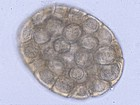Dipylidium caninum
| This article has been peer reviewed but is awaiting expert review. If you would like to help with this, please see more information about expert reviewing. |
| Dipylidium caninum | |
|---|---|
| Kingdom | Animalia |
| Phylum | Platyhelminthes |
| Class | Cestoda |
| Sub-class | Cyclophyllidea |
| Family | Dipylidiidae |
| Genus | Dipylidium |
| Species | D. caninum |
Also known as: Double-pored tapeworm — Cucumber seed tapeworm
Introduction
D. caninum is a very commonly seen parasite of dogs and cats, and of the class Cestoda. They are capable of growing up to 50cm in length in the small intestine. It is of minor clinical significance, causing no more than occasional anal irritation. Diarrhoea may result if the tapeworms are present in large numbers. The proglottids are motile and can upset owners when they drop onto the furniture or floor.
Identification
D. caninum resemble Taenia spp, but are considerably shorter than Taenia. D. caninum have a scolex and a proglottid, which are easily recognized in this species. This parasite also has two sets of genital organs.
The eggs are 25-50μm in length.
Life-Cycle
The oncospheres are within the egg packets. These are ingested by the intermediate host. They develop into cysticercoids, which is infective by the time that metamorphosis is complete.
Complete development in the intermediate hosts lasts around 1 month. The final host is infected via ingestion of the flea or louse, containing the cysticercoid.
Literature Search
Use these links to find recent scientific publications via CAB Abstracts (log in required unless accessing from a subscribing organisation).
Dipylidium caninum publications

